Power Like A Pro
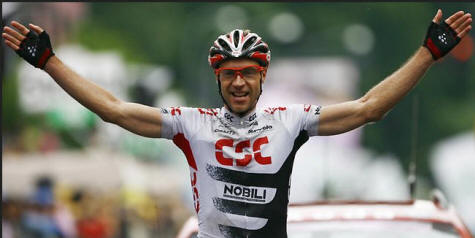
Okay, as promised, here it is. Just how good are the pros? Bloody good is the answer.
To ensure fair play, I can confirm that for the accuracy of comparison, that for the purpose of this report, we were both using the same SRM Professional power system and the same analysis software.
My SRM is recalibrated before each ride, so all the wattages below are as accurate as we can get them. Which makes the results even more scary.
The
Riders
Before we get to the pros lets talk about me (for a change).
I'm
a middle-aged scouser, haven't "raced" locally (Jersey) for the last three years, have lost a little
top end speed
but have built up loads of endurance in the
sportives I now take part in
all over Europe.
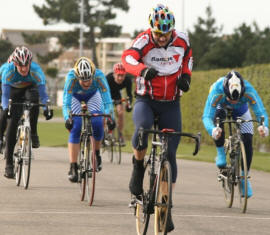 I have a collection of
Island Championship medals and have won a couple of Crit Championships.
I have a collection of
Island Championship medals and have won a couple of Crit Championships.
I'm nothing special but I'm no slouch either.
I'm probably just like you, love riding my bike and wish I had more time to be better!
So, for the sake of this comparison, who are we comparing ourselves against?
Jens Voigt, German; Tour de France yellow jersey wearer, at the peak of his career, as strong as an ox, creates breakaways for fun, recently won the Tour of Germany and looks to be (watching Overcoming) a normal bloke just like us. Except, he's exceptionally talented and probably wishes he could spend more time at home with his family.
As you can see, we're nothing alike. The only thing we have in common is a dodgy haircut, a funny accent and we ride a bike.
The Races
Comparing the races is as about
as close a match as comparing the riders. But each rider took part
in an event comparable to their abilities and it's the only info we have
to go on, so here goes.
My event was a 40 mile (60K) handicap road race, Jens' was the 216 km long, third stage of the Tour de France from Esch-sur-Alzette to Valkenburg. I rode round a four mile circuit, Jens rode from Luxembourg, through Belgium to Holland.
I had an elevation of about 10 meters, Jens rode a cross between Liege-Bastogne-Liege and Amstel Gold, through lumpy spring classics country. I started at 7:30 am in 18 degrees, Jens kicked off at mid-day where the temperature was 30 degrees at the start.
I rode tempo and through and off in the first group while we tried to stay away from the chasers. Jens went on the attack and made them chase him. After 35 minutes Jens went for it alone but was quickly joined by Jerome Pineau and others; there were 200 kilometres still to go!
Attacking
Power Outputs
I've taken the two key moments in
each of our races to highlight the not unexpected gap between our two
subjects. I've taken the respective 90 seconds of action when Jens
attacked to make his break and when I jumped to follow a chase to the
leaders.
| Jens Voigt | Tony Williams | |
| Max Power | 1187w | 764w |
| Avg Power | 515w | 298w |
| Distance covered |
0.717 miles |
0.650 miles |
| Max Crank Torque |
1128 lb sq in |
645 lb sq in |
| Avg Crank Torque |
443 lb sq in |
283 lb sq in |
As you can see, and would expect, there are differences between us.
At this point of my season I was knocking out just under 1000 watts peak power during training (can hit 1150 watts when on form) so I'm more than happy that Jens' is "only" 1200-ish.
For this season my average 90 second threshold power output is 400 watts, Jens' is 515 watts. The gap, to me, is not earth shatteringly wide, I'm only 20% away from one of the worlds top pro riders over 90 seconds!
The distance covered during the 90 seconds attack is close because I was on a rising false flat and Jens was on a small climb. When he attacked he couldn't build the outright speed needed to cover a larger distance.
What about an hour?
As you can see above Jens' figures are impressive, and mine,
I'm just an average rider remember, aren't too bad for someone of my
weight.
Most people reading this will probably be around similar figures to me. You can check out the power profiles for local wVO2max tests to see where "most" people fit in. So the question now is, how big is the gap over an hour?
First, lets paint the scenario. Voigt went off alone and "waited" for others to join him to allow the attack to develop. Once the composition of the break was formed to everyone's liking, the hammer went down.
In the first hour the gap opened to five and a half minutes. Jens was only 36 seconds down on the yellow jersey of Husovd so Credit Agricole controlled the gap by chasing to keep it around the five minute mark.
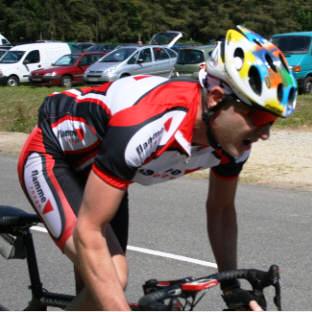
Now to the figures.
For an hour our power figures diverge at a great rate of knots. The pros have massive engines that just churn out power at a rate of which us mere mortals can only dream. My one hour normalised power for our comparator event was 214 watts, as I got to share the load with my group.
At the point of this early season race, my average normalised power for one hour is 279 watts, so this race was "way easier" than my normal training routine.
However, Jens' power output for the first hour of his break was a remarkable 385 watts as he had a smaller group (although that's obviously not the only reason!). The difference is now 79%!
During his break's first hour, Jens' average speed was an astonishing 29.9 mph. As this included short maximums and minimums of 42 and 19 mph respectively, we can see there were no real hills during this time that could skew these figures.
This speed was due to out and out brute force that only the pros can sustain. This hour took them from 48 miles into the stage, to mile 78. During this time the temperature rose to a dehydrating 35 degrees.
To
Infinity and Beyond
What's even more remarkable are Jens' efforts sustained over the
duration of the whole breakaway. For four hours thirty-nine
minutes Voigt smashed out a normalised power of 344 watts with a max,
going for the sprint at Spa, of 1260 watts.
The break, driven by Voigt who never shirks his turn, stayed away for 126 miles and averaged exactly 27 mph at a pace of 2 minutes 13 seconds per mile.
For Voigt the entire 137 mile stage took five hours, twelve minutes at a normalised power of 338 watts, an average speed of 26.3 mph and at a pace of 2 minutes 17 seconds per mile.
My nearest SRM measured equivalent would be La Danguillaume. To be honest, not my best event as I blew my nuts off with 25 miles to go but still manage to finish 15th, however it did produce some comparative figures for us to review,
| Jens Voigt | Tony Williams | ||
| Event | Stage 3 TdF | Hilly Cyclo | |
| Distance | 137 miles | 101 miles | |
| Time |
5 h 12 mins |
5 h 24 mins |
|
| Normalised Power |
338 watts |
195 watts |
|
| Average Speed |
27.0 mph |
18.9 mph |
|
| Pace minutes/mile |
2:13 |
3:11 |
The longer the event the more the pros enter a league of their own. Their phenomenal engines allow them to maintain an incredible power output for an awful long time.
As you can see above, Jens had a normalised power of 338 watts for over five hours. That's 4.4 w/kg! Mine was 195 watts (2.5 w/kg), a difference of 73%. I was only 20% down at 90 seconds; how did that happen?
Real People Power
Here's my 2009/10 season power curves. I can knock out 338 watts for the
grand total of three minutes and twenty four seconds. How sad is that?
What on earth would it take to get me from three minutes to five hours?
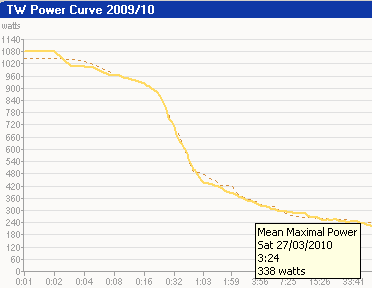
Talent for one and time for the other. Sadly, I'm lacking both. But in all my dreams I win all my races. So in my own little world, I'm as happy as I can be.
My current six minute wattage is at 3.78 w/kg, come the season start I expect to be 4w/kg and at the season height, 4/6 w/kg, or above. If you think you could knock out better (it's a lot harder than it sounds) study the wVO2max profiles, then come and test yourself against me and everyone else, including Jens, whose 6 minute power I calculate to be around 480 watts at 6.22 w/kg.
Here is a screen dump of one of the Island's top multi-medal winning vets (no not me!) on a threshold endurance test.
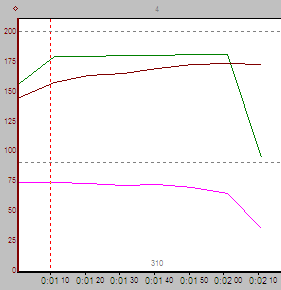
His winter VO2max power output was 310 watts . We carried out a threshold endurance test at 310 watts to see how long he could ride until exhaustion. He lasted a minute. Although to be fair it was at the beginning of his training period. I'd say he could probably last five by now!
If you want to suffer like a pro, on a normal bike go for a ride at 27 mph and see how long it is before you have to stop. Once you drop below 27mph it's over; twenty-six and a half doesn't count.
However long you last, imagine trying to do it for five hours. Remember power increases exponentially to speed. Ten percent speed requires a lot more than ten percent more power. So don't ride at 25 mph (10% less speed) and think you're just ten percent below a pros power output!
Check out my SRM sprint on the chain gang to see how a lot of power only returns a little speed.
The Message
As you can see, the pros ride at a pace, output and level of which we
can all be in awe. Until these power measuring systems became
available it was difficult to put their efforts in to context.
Because we can now ride the same events as the pros (through the ever expanding world of sportifs) and use the same equipment (SRM's, PowerTaps etc) we can get a direct comparison of where we are in the scheme of things. The gaps are frighteningly large. Which makes their achievements all the more remarkable.
To see exactly how good the pros are, or how bad I am, compare the two power distribution charts below, taken from our respective races, and discuss. It says it all really!
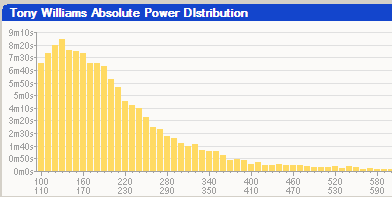
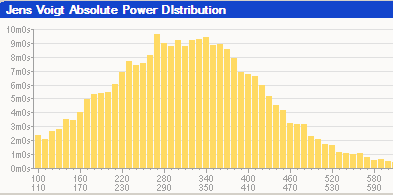
Happy Endings
On this day Jens and his break were finally caught with 7 kilometres to
go. But he did get his rewards. He won the longest stage,
the five, category four climbed, 230 kilometre, stage 13 in to Montelimar.
After an attack and forcing a break with 207k to go and in 34 degree
heat!
Obviously, and luckily, he never learnt or was put off from his first efforts. Don't you just wish you had a tenth of his talent?








